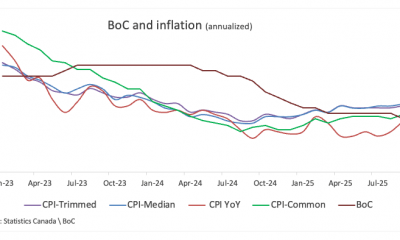

others
Japanese Yen edges lower despite more FX intervention risks – Crypto News
- The Japanese Yen edges lower as the US Dollar improves due to higher Treasury yields.
- Japanese Chief Cabinet Secretary Yoshimasa Hayashi has expressed readiness to utilize all available measures concerning forex matters.
- Fed’s Goolsbee stated that the US economy appears to be on track to achieve 2% inflation.
The Japanese Yen (JPY) trims its gains as the US Dollar (USD) strengthens, buoyed by improved Treasury yields. However, the JPY’s volatility is anticipated to persist amid speculation of intervention by Japanese authorities following weaker-than-anticipated US Consumer Price Index (CPI) figures. Traders await the Michigan Consumer Sentiment Index and US Producer Price Index (PPI), due on Friday, to gain further impetus on the US economy.
Japanese Chief Cabinet Secretary Yoshimasa Hayashi stated his readiness to employ all available measures regarding forex. Hayashi noted that the Bank of Japan (BoJ) would determine the specifics of monetary policy. He expects that the BoJ will implement appropriate measures to sustainably and steadily achieve the 2% price target, reported by Reuters on Friday.
The Bank of Japan (BoJ) could raise interest rates at its upcoming July meeting. This expectation bolstered the JPY, contributing to a decline in the USD/JPY pair.
Daily Digest Market Movers: Japanese Yen experiences fluctuations amid intervention threats
- On Friday, Japanese Finance Minister Shunichi Suzuki emphasized that rapid foreign exchange (FX) movements are undesirable. Suzuki refrained from commenting on FX intervention and declined to address media reports regarding Japan’s FX rate checks, as reported by Reuters.
- Federal Reserve Bank of Chicago President Austan Goolsbee said on Thursday that the US economy appears to be on track to achieve 2% inflation. Goolsbee stated “My view is, this is what the path to 2% looks like,” according to Reuters.
- The US Consumer Price Index (CPI) declined by 0.1% month-over-month in June, marking its lowest level in over three years. The headline CPI increased by 3.0% MoM in June, down from a 3.3% rise in May and below the market consensus of 3.1%.
- The core CPI, which excludes volatile food and energy prices, rose by 3.3% year-over-year in June, compared to May’s increase of 3.4% and the same expectation. Meanwhile, the core CPI increased by 0.1% month-over-month, against the expected and prior reading of 0.2%.
- Peter Boockvar, chief financial officer at US-based Bleakley Financial Group, said that the Yen’s weakness will trigger the BoJ to “react sooner rather than later,” per Reuters.
- Reuters reported on Wednesday, citing unnamed sources, the Bank of Japan will likely trim this year’s economic growth forecast and project inflation will stay around its 2% target in coming years at its meeting this month.
- Federal Reserve Chairman Jerome Powell highlighted the urgent need to monitor the deteriorating labor market on Wednesday. Additionally, Powell expressed confidence in the downward trend of inflation, following his remarks on Tuesday that emphasized the necessity of further data to strengthen confidence in the inflation outlook.
- According to a Bloomberg report on Tuesday, the Bank of Japan is conducting three in-person meetings with banks, securities firms, and financial institutions over the next few days. These meetings aim to assess a feasible pace for scaling back its purchases of Japanese Government Bonds.
Technical Analysis: USD/JPY rebounds toward 159.50
USD/JPY trades around 159.30 on Friday. The daily chart analysis shows a weakening bullish bias as it breached the lower boundary of an ascending channel pattern. Additionally, the 14-day Relative Strength Index (RSI) was slightly below the 50 level, indicating a decline in the momentum of the pair’s price.
The USD/JPY pair may find initial support near the psychological level of 109.00. A break below this level could reinforce bearish sentiment, potentially prompting a revisit to June’s low near 104.55.
On the upside, immediate resistance is seen around the 21-day Exponential Moving Average (EMA) at 109.82, followed by the lower boundary of the ascending channel near 109.95. A return to within the ascending channel would likely improve sentiment for the USD/JPY pair, potentially targeting the upper boundary of the channel around the 113.20 level.
USD/JPY: Daily Chart
Japanese Yen PRICE Today
The table below shows the percentage change of Japanese Yen (JPY) against listed major currencies today. Japanese Yen was the weakest against the Canadian Dollar.
| USD | EUR | GBP | JPY | CAD | AUD | NZD | CHF | |
|---|---|---|---|---|---|---|---|---|
| USD | 0.00% | 0.06% | 0.18% | -0.03% | -0.02% | -0.02% | -0.04% | |
| EUR | -0.01% | 0.05% | 0.19% | -0.05% | -0.05% | -0.04% | -0.07% | |
| GBP | -0.06% | -0.05% | 0.14% | -0.11% | -0.10% | -0.09% | -0.12% | |
| JPY | -0.18% | -0.19% | -0.14% | -0.26% | -0.22% | -0.23% | -0.25% | |
| CAD | 0.03% | 0.05% | 0.11% | 0.26% | 0.01% | 0.00% | -0.05% | |
| AUD | 0.02% | 0.05% | 0.10% | 0.22% | -0.01% | 0.00% | -0.03% | |
| NZD | 0.02% | 0.04% | 0.09% | 0.23% | -0.00% | -0.00% | -0.02% | |
| CHF | 0.04% | 0.07% | 0.12% | 0.25% | 0.05% | 0.03% | 0.02% |
The heat map shows percentage changes of major currencies against each other. The base currency is picked from the left column, while the quote currency is picked from the top row. For example, if you pick the Japanese Yen from the left column and move along the horizontal line to the US Dollar, the percentage change displayed in the box will represent JPY (base)/USD (quote).
Economic Indicator
Michigan Consumer Sentiment Index
The Michigan Consumer Sentiment Index, released on a monthly basis by the University of Michigan, is a survey gauging sentiment among consumers in the United States. The questions cover three broad areas: personal finances, business conditions and buying conditions. The data shows a picture of whether or not consumers are willing to spend money, a key factor as consumer spending is a major driver of the US economy. The University of Michigan survey has proven to be an accurate indicator of the future course of the US economy. The survey publishes a preliminary, mid-month reading and a final print at the end of the month. Generally, a high reading is bullish for the US Dollar (USD), while a low reading is bearish.
Next release: Fri Jul 12, 2024 14:00 (Prel)
Frequency: Monthly
Consensus: 68.5
Previous: 68.2
Source: University of Michigan
-

 Technology1 week ago
Technology1 week agoSam Altman says OpenAI is developing a ‘legitimate AI researcher’ by 2028 that can discover new science on its own – Crypto News
-

 Technology1 week ago
Technology1 week agoBenQ MA270U review: A 4K monitor that actually gets MacBook users right – Crypto News
-

 Technology1 week ago
Technology1 week agoGiving Nvidias Blackwell chip to China would slash USs AI advantage, experts say – Crypto News
-

 others1 week ago
others1 week agoBank of Canada set to cut interest rate for second consecutive meeting – Crypto News
-

 De-fi1 week ago
De-fi1 week agoBittensor Rallies Ahead of First TAO Halving – Crypto News
-

 Business1 week ago
Business1 week agoStarbucks Says Turnaround Strategy Drives Growth in Global Sales – Crypto News
-

 Blockchain1 week ago
Blockchain1 week agoSolana Eyes $210 Before Its Next Major Move—Uptrend Or Fakeout Ahead? – Crypto News
-

 De-fi1 week ago
De-fi1 week agoREP Jumps 50% in a Week as Dev Gets Community Support for Augur Fork – Crypto News
-

 others7 days ago
others7 days agoMETA stock has lower gaps to fill – Crypto News
-

 De-fi1 week ago
De-fi1 week agoCrypto Market Edges Lower While US Stocks Hit New Highs – Crypto News
-
others1 week ago
Pi Coin Gains Another 15% As Pi Network Joins ISO 20022 For Seamless Banking Integration – Crypto News
-

 Cryptocurrency3 days ago
Cryptocurrency3 days agoAndrew Tate Buys $5 Million Worth of Bitcoin Hours Before Crash – Crypto News
-
Cryptocurrency6 days ago
After 1,993% Burn Spike, Is Shiba Inu Price Set for a Major Trend Reversal? – Crypto News
-
others1 week ago
Crypto Market Tumbles as Jerome Powell Says December Rate Cut ‘Far From Certain’ – Crypto News
-

 De-fi1 week ago
De-fi1 week agoBitcoin Dips Under $110,000 After Fed Cuts Rates – Crypto News
-

 Cryptocurrency2 days ago
Cryptocurrency2 days agoMany Crypto Treasury Companies Were a Get-Rich-Quick Trap, Warns Columbia Professor – Crypto News
-

 De-fi1 week ago
De-fi1 week agoTokenized Nasdaq Futures Enter Top 10 by Volume on Hyperliquid – Crypto News
-

 Cryptocurrency1 week ago
Cryptocurrency1 week agoCitigroup and Coinbase partner to expand digital-asset payment capabilities – Crypto News
-

 De-fi1 week ago
De-fi1 week agoCRO Jumps After Trump’s Truth Social Announces Prediction Market Partnership with Crypto.Com – Crypto News
-
others1 week ago
Can ASTER Price Rebound 50% as Whale Activity and Bullish Pattern Align? – Crypto News
-

 Blockchain7 days ago
Blockchain7 days agoSmart Money Buys the Dip – Crypto News
-

 Cryptocurrency6 days ago
Cryptocurrency6 days agoZIGChain eyes gains as Nasdaq-Listed SEGG Media backs ZIG – Crypto News
-

 Cryptocurrency3 days ago
Cryptocurrency3 days agoAndrew Tate Buys $5 Million Worth of Bitcoin Hours Before Crash – Crypto News
-

 Cryptocurrency3 days ago
Cryptocurrency3 days agoLitecoin: $855K ETF inflow sparks new life – Next target is $105 IF… – Crypto News
-

 Cryptocurrency2 days ago
Cryptocurrency2 days agoBitcoin tests $100K support after massive liquidation event rocks market – Crypto News
-
others1 week ago
Pi Network Patterns Point to More Gains Despite Manipulation Claims – Crypto News
-
Technology1 week ago
Breaking: $2.6B Western Union Announces Plans for Solana-Powered Stablecoin by 2026 – Crypto News
-
Business1 week ago
BNB Chain’s Future Growth Won’t Come From DEXs – Crypto News
-

 Cryptocurrency1 week ago
Cryptocurrency1 week agoInside Bitwise’s milestone solana ETF launch – Crypto News
-

 Cryptocurrency1 week ago
Cryptocurrency1 week agoWhy Is Pi Network’s (PI) Price Up by Double Digits Today? – Crypto News
-

 Blockchain1 week ago
Blockchain1 week agoCZ Weighing Lawsuit Against US Senator over Money Laundering Claim: Report – Crypto News
-

 Blockchain1 week ago
Blockchain1 week agoBasel Reportedly Aims for Friendlier Crypto Bank Guidelines – Crypto News
-

 Cryptocurrency7 days ago
Cryptocurrency7 days agoIs the Market Finally Learning to Handle Volatility? – Crypto News
-

 Metaverse6 days ago
Metaverse6 days agoAI boom is just beginning – Nvidia CEO Jensen Huang explains what’s driving the virtuous cycle – Crypto News
-

 Cryptocurrency2 days ago
Cryptocurrency2 days agoStrategy IPO redefines corporate Bitcoin strategy with euro-denominated offering – Crypto News
-

 Cryptocurrency1 week ago
Cryptocurrency1 week agoKERNEL price goes vertical on Upbit listing, hits $0.23 – Crypto News
-

 Blockchain1 week ago
Blockchain1 week agoVisa To Support Four Stablecoins on Four Blockchains – Crypto News
-

 Cryptocurrency1 week ago
Cryptocurrency1 week agoArbitrum beats Ethereum in inflows: Yet ARB price lags – Here’s why – Crypto News
-

 Technology1 week ago
Technology1 week agoEthereum Foundation launches institutional portal to boost enterprise adoption – Crypto News
-
Business1 week ago
Bitcoin Price Forecast as Trump Cuts Tariffs After US-China Trade Deal – Crypto News
-
Technology1 week ago
XRP Price Outlook as ETF Nears Possible November 13 Launch – Crypto News
-
Business1 week ago
Not L1s or Wallets – Who Generates the Bulk of Crypto’s $20B in Revenue? – Crypto News
-
others6 days ago
Pi Coin Price Prediction After AI Investment Announcement – Is a Bull Run Ahead? – Crypto News
-
Technology1 week ago
Breaking: $2.6B Western Union Announces Plans for Solana-Powered Stablecoin by 2026 – Crypto News
-
others1 week ago
When liquidity becomes the new frontier – Crypto News
-

 Blockchain1 week ago
Blockchain1 week agoBitcoin Cost Basis Map Reveals Key War Zone Between Bulls & Bears – Crypto News
-
others1 week ago
Cardano Price Risks 20% Crash Amid Death Cross and Falling ADA ETF Odds – Crypto News
-
Technology1 week ago
Canary XRP ETF Filing Removes SEC Delay Clause, Targets November Launch – Crypto News
-
others6 days ago
Russia S&P Global Manufacturing PMI dipped from previous 48.2 to 48 in October – Crypto News
-

 Cryptocurrency6 days ago
Cryptocurrency6 days agoHBAR under pressure, Descending channel hints at 24% downside move – Crypto News




